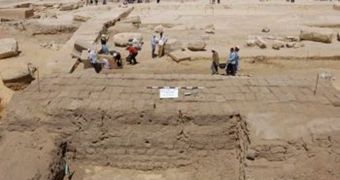Archaeologists conducting a routine dig around the Great Sphinx of Giza, in Egypt, have stumbled upon what look like mud walls, which were most likely used as defensive measures to protect the remarkable monument.
Experts from the Supreme Council of Antiquities (SCA) of Egypt say that the walls were most likely not built to keep possible intruders at bay, but rather to protect the statue against the damaging effects of being exposed to desert sands and winds
In an announcement made Tuesday, November 2, the SCA representatives said that the walls are about 1 meter (3.3 feet) tall, and that two of them were discovered on the Giza Plateau.
This location is renowned around the world, because it houses the Sphinx and the three Great Pyramids, which are tombs of ancient Egyptian pharaohs.
The structures are considered to be one of the seven wonders of the ancient world, alongside structures such as the Hanging Gardens of Babylon and the Lighthouse of Alexandria.
SCA Secretary-General Zahi Hawass, the leader of the new digs, says that the two new wall segments were running in different directions, one of them from north to south and the other east to west.
The former was found to have a length of 282 feet, or 86 meters, but was probably larger when it was constructed. The second wall is 151 feet (46 meters) long, LiveScience reports.
Ancient Egyptian texts hold that King Thutmose IV was the one who built the walls. Legend has it that the leader was hunting around the Sphinx one day, and that he had a dream about the statue.
In it, the Sphinx was telling him to clear the sand from around its base. In return, the Sphinx would make King Thutmose IV the ruler of Egypt. The ruler agreed, and ordered the wall to be erected.
But scholars believed until now that the structure had only been raised on the northern side of the monument. The recent digs disprove that, and shows that the King held his promise to the Sphinx.
In related news, a team of archaeologists also discovered a third wall near the temple of King Khafre, who was the ruler that built the second-largest pyramid at the site. The wall runs east of the temple.
Experts believe that after Khafre died, around 2532 B.C., a settlement grew near his pyramid, and that the walls are part of that small village. The place was most likely inhabited by priests and other officials, who were in charge of the former Pharaoh's death cult.
SCA officials estimate that a lot of the country's relics and monuments are still hidden in the sands, and that they will be reveals with time.

 14 DAY TRIAL //
14 DAY TRIAL //